Every time I go to grab a snack at home, I find myself staring at an advertisement. And I’m not talking about the packaging of the food itself – my roommate has hung a calendar from our local pharmacy on the inside of the cabinet. You probably have one of these somewhere in your home – whether it be from the local Chinese restaurant, hardware store, bank, or doctor’s office. Businesses ingratiating themselves among their customers by providing them with a useful item (with a little advertisement for themselves, of course) is hardly a new concept – in fact it has been in practice for well over a hundred years. While today fridge magnets and calendars are commonplace, historically it wasn’t unheard of for a business to print useful cards with train schedules. What better way to remain at the forefront of your customers’ mind than to have your ad on a card they carry around everywhere?
Unofficial timecards are fairly easy to pick out – they bear no official railroad logo or marking – and generally have a whole lot of ads. They also use the railroad’s original name – the New York and Harlem – which was a name everybody knew, as opposed to calling it the Harlem Division, as the railroad did by this time.
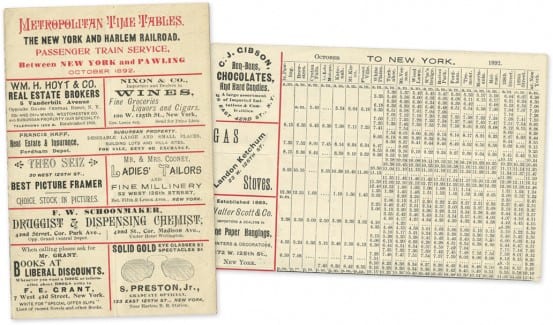
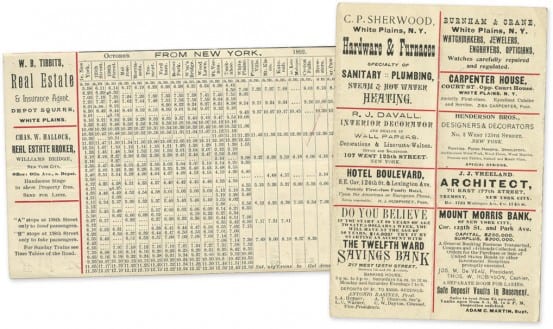
Train timecard from Pawling, 1892. A bifold card, the outside features advertisements for numerous businesses. In featuring only weekday trains, the card is tailored to the businessman that would likely patronize the featured establishments. For those looking for Sunday trains, the card advises to consult an official timetable “of the road.”
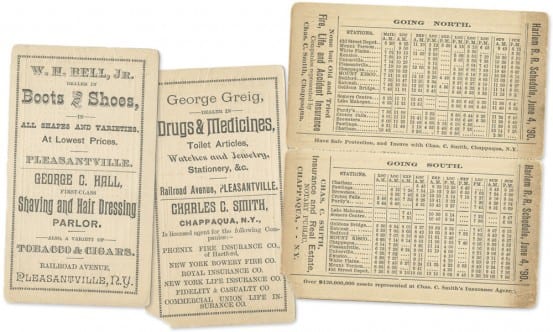
Timecard from 1890, featuring selected stops along the Harlem, all the way up to Chatham. Also a bifold, this card is likely more successful than the unwieldy one above, as it would easily fit into your pocket.
Although I wouldn’t classify it as an advertisement like above, the Woodlawn Cemetery also printed their own small time cards. You’ll note a great comparison below – an official railroad-printed Woodlawn time card, along with one printed by the cemetery itself. Besides the address and phone numbers of the cemetery, the card also contains an edited list of train times – corresponding with the cemetery’s hours – of course!
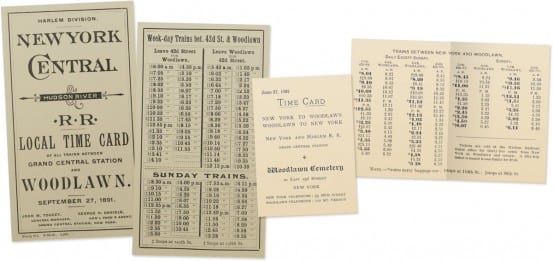
Timecards from Woodlawn. The 1891 card at left is official and printed by the railroad. The 1892 card at right was printed by the Woodlawn Cemetery.
Eventually, local timetables did become standardized – printed by the railroad, but still containing advertisements. Below is a nice collection of some local timetables throughout the years. Make sure you note an important portion of the design – the top of every New York Central local timetable is labeled as “official.” By the time the Penn Central came into being, this disclaimer was dropped. Also in the mix is a more current version of Metro-North’s local timetable. The new design still contains advertisements, but they’ve been relegated to the inside.


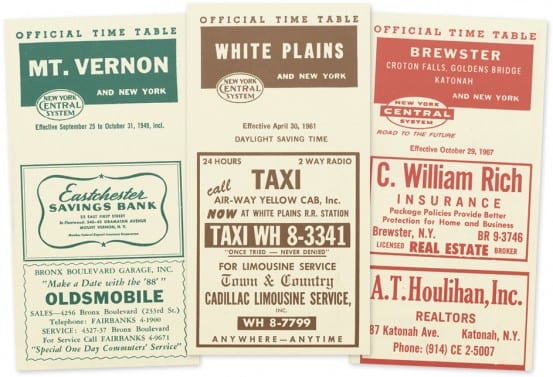
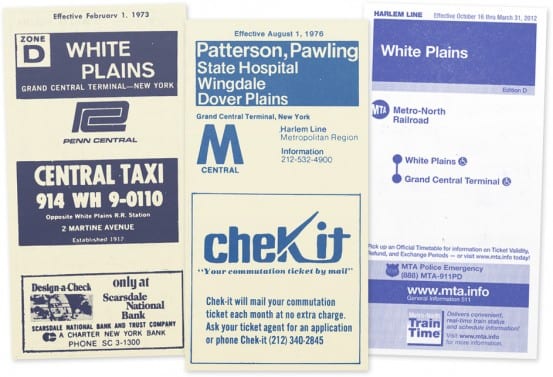
I always wondered why railroads put “official” on their small timetables. It never occurred to me that there were non-railroad issued unofficial ones floating around. Great story!
Thanks for this information! I didn’t know their were “unofficial” timetables either.
You are a member of the “Club”, Steve, along with Otto and me: former Katonah residents. What a great place it was!
Just plain cool stuff! Thanks, Emily.
For years, on the inside of a local timetable is a notation in fine print, “Authorized and distributed by MetroNorth, published by Titan” (or the particular railroad and advertising agency; in the old days it was Penn Central and TDI).
I believe the local timetables are and have been published by an advertising company under an arrangement with the railroad. The advertiser sells ad space and prints the schedule, the railroad distributes it. It’s a win-win for everyone–the railroad gets free printing and maybe even a commission, the advertiser sells ads, and commuters get a convenient pocket-sized timetable.
For some reason, NJ Transit and SEPTA do not use this system, although their predecessor railroads did.
Note the “Zone D” on the White Plains schedule. In February, 1965, the New York Central announced zoned express trains on the Harlem Line, dividing the line into a groups of stations. At that time, the four zones were: Mount Vernon and Fleetwood; Bronxville, Tuckahoe, and Crestwood; Scarsdale and Hartsdale; and White Plains and White Plains North. [New York Times, 1/20/1965, pg 41.]
Also, on the older timetables, note the old style of telephone numbers using exchange names instead of numbers, such as KL 5-2368 (or KLondike 5-2368). Telephone users were very reluctant to give up their exchange names for numbers. One could make a hit song out of PEnnsylvania 6, not so much with 736.
Speaking of calendar advertising, for many years the Pennsylvania Railroad published a promotional calendar with a distinctive painting. An excellent book describes the history: “Crossroads of Commerce The Pennsylvania Calendar Art of Grif Teller” by Dan Cupper; Great Eastern Publishing, 1992. The book also has a chapter on the Osborne Company, an advertising and printing house that published the PRR calendars for the railroad.